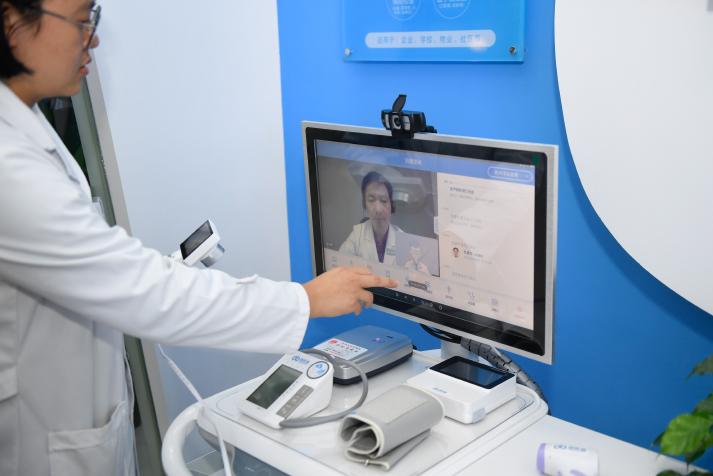|
||||||
|
||||||
| Home Nation World Business Opinion Lifestyle China Focus ChinAfrica Video Multimedia Columnists Documents Special Reports |
|
||||||
|
||||||
| Home Nation World Business Opinion Lifestyle China Focus ChinAfrica Video Multimedia Columnists Documents Special Reports |
| Nation |
| Filling the Gap |
| Epidemic boosts the development of telemedicine |
| By Yuan Yuan · 2020-04-03 · Source: NO.15 APRIL 9, 2020 |
 A staff member at the Internet hospital of Wuzhen, Zhejiang Province, operates telemedicine equipment on November 6, 2018 (XINHUA)
Fan Gaowei, a physician in Yuncheng, Shanxi Province in north China, has been very busy since the outbreak of the novel coronavirus (COVID-19). He communicates with over 100 patients every day, provides diagnosis and receives payment, all via an app called Medlinker.
As visiting the hospital became a challenge during the epidemic outbreak, the online medical care industry saw a sharp increase in demand. Online medical platforms acted fast to fill the gap. On January 22, one day before Wuhan, the epicenter of the epidemic in China, was locked down, Medlinker launched its free medical consultation service platform. By March 22, it had connected over 4,000 respiratory and infectious disease doctors with more than 360,000 patients. A growing industry Medlinker mainly serves people with chronic diseases. From the outbreak to March 22, it had seen a tripling of the number of patients registered with the platform and a 159-percent increase in the number of medical consultations conducted via it, according to a report on Sina.com. Telemedicine has been developing in China for years. In 2000, the Sanjiu Enterprise Group, a large state-owned pharmaceutical enterprise in China, launched a website offering medical care information. It is regarded as China's first such platform. In the same year, Dxy.cn, a website designed for medical professionals to share knowledge and experiences, was also set up. In the following years, telemedicine has experienced ups and downs. In the early stage of its development, one of its aims was to help patients in remote areas get easier access to high-quality medical resources in more developed areas. In 2014, the industry witnessed an upsurge. In that year, Ping An, one of China's largest health insurers, launched the platform Good Doctor, covering a wide range of services and available 24 hours a day. In December 2015, China's first Internet hospital was set up in Wuzhen, Zhejiang Province in east China, marking a new era of telemedicine in China. E-commerce giants JD.com and Alibaba have both set up their own e-health platforms, JD Health and Ali Health, respectively. The government has issued a series of notices and guidelines to regulate the industry. In 2018 alone, the National Health Commission (NHC) issued three important administrative measures for telemedicine. By October 2019, the number of Internet hospitals in China reached 269. "However, despite the rise in the number, many people still prefer to visit a physical hospital to receive medical help," said Cai Xiujun, an expert from Zhejiang. "It will take some time before people develop the habit of going to Internet hospitals."  Chinese and foreign enterprises showcase hi-tech electronic medical products at the Fourth China-Arab States Expo held in Ningxia Hui Autonomous Region on September 5-8, 2019. Advanced equipment makes medical consultation through the Internet possible (XINHUA)
The turning point The epidemic has brought a sudden change in the situation. "This epidemic is believed to be the turning point in the recognition of online medical care," said Wang Shirui, founder of Medlinker. "Contactless medical services have reduced the risk of cross infection. People will gradually realize that they can get general consultation and prescriptions for chronic diseases online without having to go to hospital, and will get used to using online medical service platforms in the future." Currently, there are about 130,000 medical enterprises registered online. Wang Chaohui, a traditional Chinese medicine doctor from Nanning, capital city of Guangxi Zhuang Autonomous Region in south China, has worked both offline and online since February 8 after the hospital he works for opened free online consultation services. "It is normal for me to work past midnight," Wang Chaohui told a local newspaper in Nanning. "Many who reached me online were worried about getting infected. Normally I can diagnose a case within 5 minutes when I talk to a patient in person. But it takes about 20 minutes for an online diagnosis." Lu Huijing, a doctor from Guangzhou, capital city of Guangdong Province in south China, said online medical care also benefits those with chronic diseases who need regular medication. "They can get prescriptions with their previous diagnosis and get the drugs delivered to their home, which is very convenient." In late January, Ali Health launched a free medical consultation portal for its users in Hubei Province, where the epidemic was most severe, with hundreds of respiratory physicians responding online. A portal on WeChat, China's popular messaging app, was also put into use at the same time to provide information and suggestions regarding COVID-19. The government also launched a series of regulations to encourage the development of this industry in the special period. On February 3, the NHC issued a notice encouraging medical institutions at various levels to offer free medical consultation online on both the epidemic and other chronic diseases, and deliver drugs. According to statistics from the NHC, during the epidemic, the number of patients receiving online diagnosis and therapies from hospitals under its administration increased 17 times year on year. Some other online platforms reported more than 20-fold increase in the number of consultations and nearly 10-time rise in the number of prescriptions over the same period last year. On March 2, the NHC launched a guideline on covering online medical services with medical insurance. In August 2019, the National Healthcare Security Administration had already issued a guideline encouraging coverage of telemedicine with medical insurance. The rocketing demand for online medical services has given a push to the implementation of regulations nationwide. On March 2, a 64-year-old patient with coronary heart disease in Beijing got his prescription online and paid with his medical insurance, becoming the first person in Beijing to enjoy this benefit. The scope of online medical services has expanded as well. For example, patients can check their blood pressure with a smart blood pressure gauge, which can automatically upload the results online for doctors to follow up. "5G and artificial intelligence will make many other possibilities come true, which will bring a new era for this industry," said Li Zhi, President of the Kyee Group, a provider of medical information service based in Beijing. But Li remains cautious about the development of this industry due to some hidden risks. "The absence of personal contact will make it harder to establish trust between patients and doctors, and it can also lead to wrong diagnosis," Li said. "The epidemic has offered a special chance for this industry to develop at a faster pace, but it still needs time to develop in a sound and healthy manner after the epidemic is over." Copyedited by Madhusudan Chaubey Comments to yuanyuan@bjreview.com |
About Us | Contact Us | Advertise with Us | Subscribe
|
||
| Copyright Beijing Review All rights reserved 京ICP备08005356号 京公网安备110102005860号 |